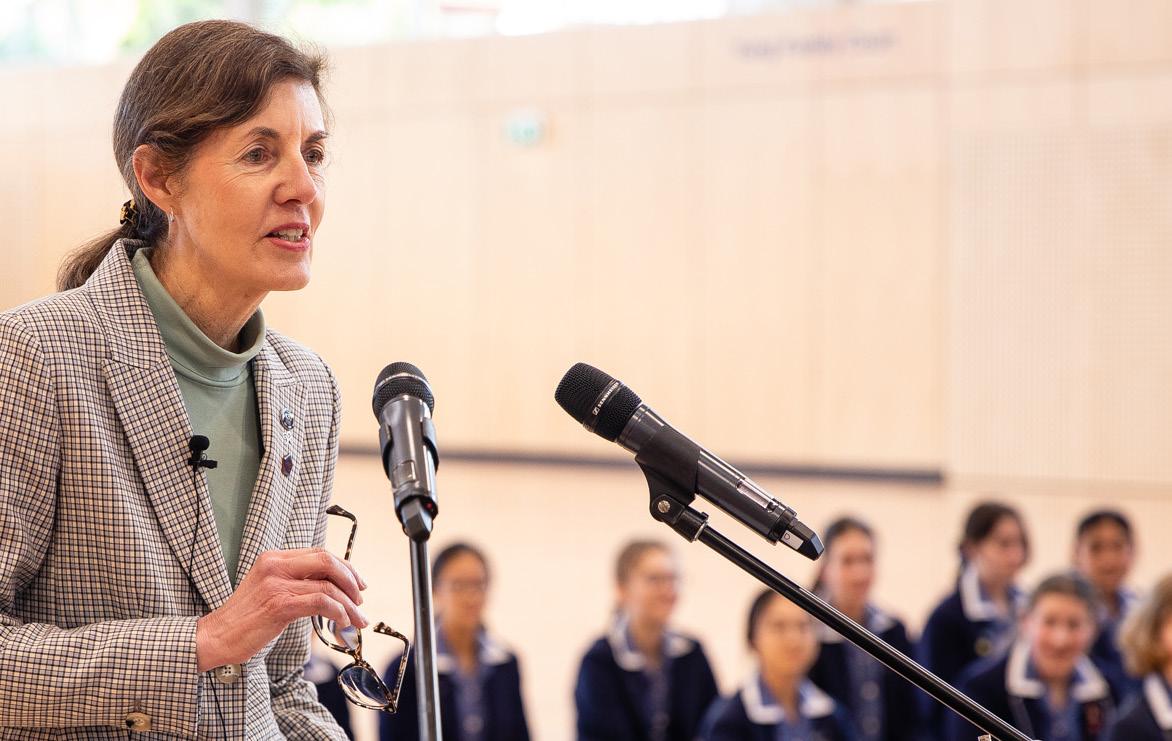
5 minute read
Principal's Perspective
Arriving at School each morning gives me the opportunity to witness so many of our Junior and Senior School students playing sport, training or generally being active. Our Rowing students can be found on the ergs if they are not doing water-based training and there is generally loud music accompanying the instructions of our various coaches. Our students participate in the Girls Sport Victoria (GSV) and School Sport Victoria (SSV) programs, as well as many various carnivals and competitions.
I see evidence that our students are demonstrating physical literacy (defined as developing the skills, knowledge and behaviours that give children and young people the confidence and motivation to lead active and healthy lifestyles) and I know that this will make a positive impact on their physical and mental health, as well as their cognitive functioning, memory, concentration and academic performance.
THE RESEARCH
There is a good deal of research which points to the benefits of physical activity for children and young people and the Australian Guidelines for children and young people aged 5 to 17 years recommends 60 minutes per day of moderate to vigorous intensity physical activity. Physical Education & Health curriculum and Sport programs provided at School help enable this.
Research from the OECD in 2019 indicated that academic performance has been improved in Australia, Chile, China, Japan, Portugal and Switzerland as an outcome of participation in Physical Education and Health curriculum. Further to this,
The World Health Organization in their Umbrella Review of Physical Activity and Academic Achievement noted that physical activity was beneficial for the development of cognitive, motor and social skills, as well as good metabolic and musculoskeletal health. Sport England in 2019 reported a positive association between engagement in sport and physical activity and levels of wellbeing for young people, while Australian Institute of Sport reports that students who have physical literacy supports the development of self-esteem and self-confidence, resilience, improved social skills, and behaviours for lifelong participation in sport and physical activity.
PHYSICAL LITERACY AND WELLBEING AT LAURISTON
An important aspect of the history of Lauriston has been the attention given to participation in physical activity and sport. Since the early years of our School, sport and physical activity were encouraged. Today, we are on our way to implementing our second Sport Strategic Plan and our vision for this plan is to enhance the physical and mental health of our students by developing lifelong habits of physical activity and wellness. We believe that through enhancing the physical activity and wellness of our students, we can foster competence, confidence and capability to pursue sport and recreational activities throughout their lives, including the development of transferable ‘soft skills’ which are highly valued as an indicator of potential to employers.
Our pillars for the Sport Strategic Plan are participation, affiliations, excellence and participation.
We choose to make participation in GSV or a recreational activity compulsory from years 7 to 10, and have enhanced our Junior School team sport participation to ensure that the youngest members of our Junior School have physical activity each day.
Our Running Clubs in both the Junior and Senior Schools have grown in popularity and our Cross Country and Athletics performances have improved as a result. In 2022 the Lauriston Netball Club continued to grow and this year we we will be trialling a Basketball Club in the Junior School with a view to expanding into the Senior School over time.
There is certainly a breadth and depth of sporting and recreational offerings for our students and everyone is encouraged to participate, regardless of skill level.
Across the School we have a well-planned Physical Education & Health curriculum which all students participate in until Year 10. We enhance this curriculum with elective subjects in the Senior School as we are committed to ensuring that our students have both encouragement and content understanding about the importance of life-long physical activity in maintaining a healthy lifestyle.
Our Howqua program enables our students to build their physical activity through Physical Education lessons and the Fitness and Outdoor Program components of the Howqua year provide an array of physical challenges for our students. Trail running is not something students can easily participate in when they reside in Melbourne, but at Howqua each student
can sequentially build her running skills and reach her own PBs. Outdoor Program activities are physically and mentally challenging, but there is considerable personal satisfaction when a hike is completed or cross-country skiing skills are developed.
THE ULLMER SPORTS & WELLBEING CENTRE
The recent opening of the Ullmer Sports & Wellbeing Centre is a continuation of the value Lauriston places on sport and physical activity as part of the education we provide to our students. Our students will benefit from facilities which enhance our current curriculum, sport and recreational offerings.
In the future, we would like to open the Ullmer Sports & Wellbeing Centre for alumnae sporting initiatives and broader community-based initiatives for girls and women.
In many ways, the Ullmer Sports & Wellbeing Centre is our ‘blue beacon’. It sends a message to our students that involvement in physical activity and sport are part of a wellrounded education and support a healthy lifestyle for now and the future years. The message for our School and broader community is one of growing healthy and strong children and young people who will see the benefit of physical activity in all aspects of their education and life.

Susan Just, Principal










